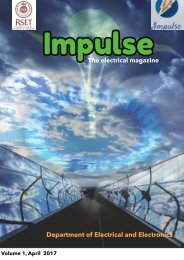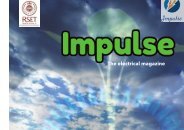impulse-ed 2-060417
Create successful ePaper yourself
Turn your PDF publications into a flip-book with our unique Google optimized e-Paper software.
IMPULSE 2017<br />
DEE, RSET<br />
So, Why use CNTs in Solar Cells?<br />
Any solar cell should have good photovoltaic properties to provide maximum number of electronhole<br />
pairs for a given intensity of incident light. The cell should be as strong as possible to improve<br />
its life and should work at maximum possible efficiency. Above all, it should be cheap. Well,<br />
CNTs have many such desirable properties that make it a potential photovoltaic material in the<br />
coming years. When light falls on a solar cell, electrons are generat<strong>ed</strong> and transferr<strong>ed</strong> to the<br />
external circuit via metallic conductors and connectors. If the photo-reception part of the cell<br />
contains CNTs, a lot of positive differences can be observ<strong>ed</strong>. This is due to the electrical properties<br />
of CNTs. They are hollow cylinders and hence electrons can only flow over its surface compar<strong>ed</strong><br />
to the conventional wires. Due to this reason, CNTs offers lesser resistance to the flow of current<br />
and can help r<strong>ed</strong>uce losses. As for light harvesting properties, carbon nanotubes possess a wide<br />
range of direct bandgaps matching the solar spectrum and its strong photoabsorption from infrar<strong>ed</strong><br />
to ultraviolet, allows it to absorb light belonging to different frequencies and wavelength. It has<br />
high carrier mobility and r<strong>ed</strong>uc<strong>ed</strong> carrier transport scattering which allows CNTs to transfer<br />
maximum current to the external load as much as possible with minimum loss of electrons within<br />
the bulk of the cell. What good can a solar cell do if it can’t protect itself from mechanical stresses?<br />
Carbon nanotubes are the strongest and stiffest materials yet discover<strong>ed</strong> in terms of tensile strength<br />
and elastic modulus respectively. In 2000, a multi-wall<strong>ed</strong> carbon nanotube was test<strong>ed</strong> to have a<br />
tensile strength of 63 gigapascals (9,100,000 psi). Since carbon nanotubes have a low density for<br />
a solid of 1.3 to 1.4 g/cm 3 , its specific strength of up to 48,000 kN•m/kg is the best of known<br />
materials, compar<strong>ed</strong> to high-carbon steel's 154 kN•m/kg.<br />
Recently, SWNTs were directly configur<strong>ed</strong> as energy conversion materials to fabricate<br />
thin-film solar cells, with nanotubes serving as both photogeneration sites and a charge carriers<br />
collecting/transport layer. The solar cells consist of a semitransparent thin film of nanotubes<br />
conformally coat<strong>ed</strong> on an n-type crystalline silicon substrate to create high-density p-n<br />
heterojunctions between nanotubes and n-Si to favor charge separation and extract electrons<br />
(through n-Si) and holes (through nanotubes). Initial tests have shown a power conversion<br />
efficiency of >1\%, proving that CNTs-on-Si is a potentially suitable configuration for making<br />
solar cells. For the first time, Zhongrui Li demonstrat<strong>ed</strong> that SOCl 2 treatment of SWNT boosts the<br />
power conversion efficiency of SWNT/n-Si heterojunction solar cells by more than 60%. Later on<br />
the acid doping approach is widely adopt<strong>ed</strong> in the later publish<strong>ed</strong> CNT/Si works. Even higher<br />
efficiency can be achiev<strong>ed</strong> if acid liquid is kept inside the void space of nanotube network. Acid<br />
infiltration of nanotube networks significantly boosts the cell efficiency to 13.8%, as report<strong>ed</strong> by<br />
Yi Jia, by r<strong>ed</strong>ucing the internal resistance that improves fill factor, and by forming<br />
photoelectrochemical units that enhance charge separation and transport. The wet acid induc<strong>ed</strong><br />
problems can be avoid<strong>ed</strong> by using align<strong>ed</strong> CNT film. In align<strong>ed</strong> CNT film, the transport distance<br />
is shorten<strong>ed</strong>, and the exciton quenching rate is also r<strong>ed</strong>uc<strong>ed</strong>. Additionally align<strong>ed</strong> nanotube film<br />
has much smaller void space, and better contact with substrate. So, plus strong acid doping, using<br />
align<strong>ed</strong> single wall carbon nanotube film can further improve power conversion efficiency (a<br />
record-high power-conversion-efficiency of >11\% was achiev<strong>ed</strong> by Yeonwoong Jung).<br />
Mr. SIDHARTH R.S.<br />
S8 EEE




